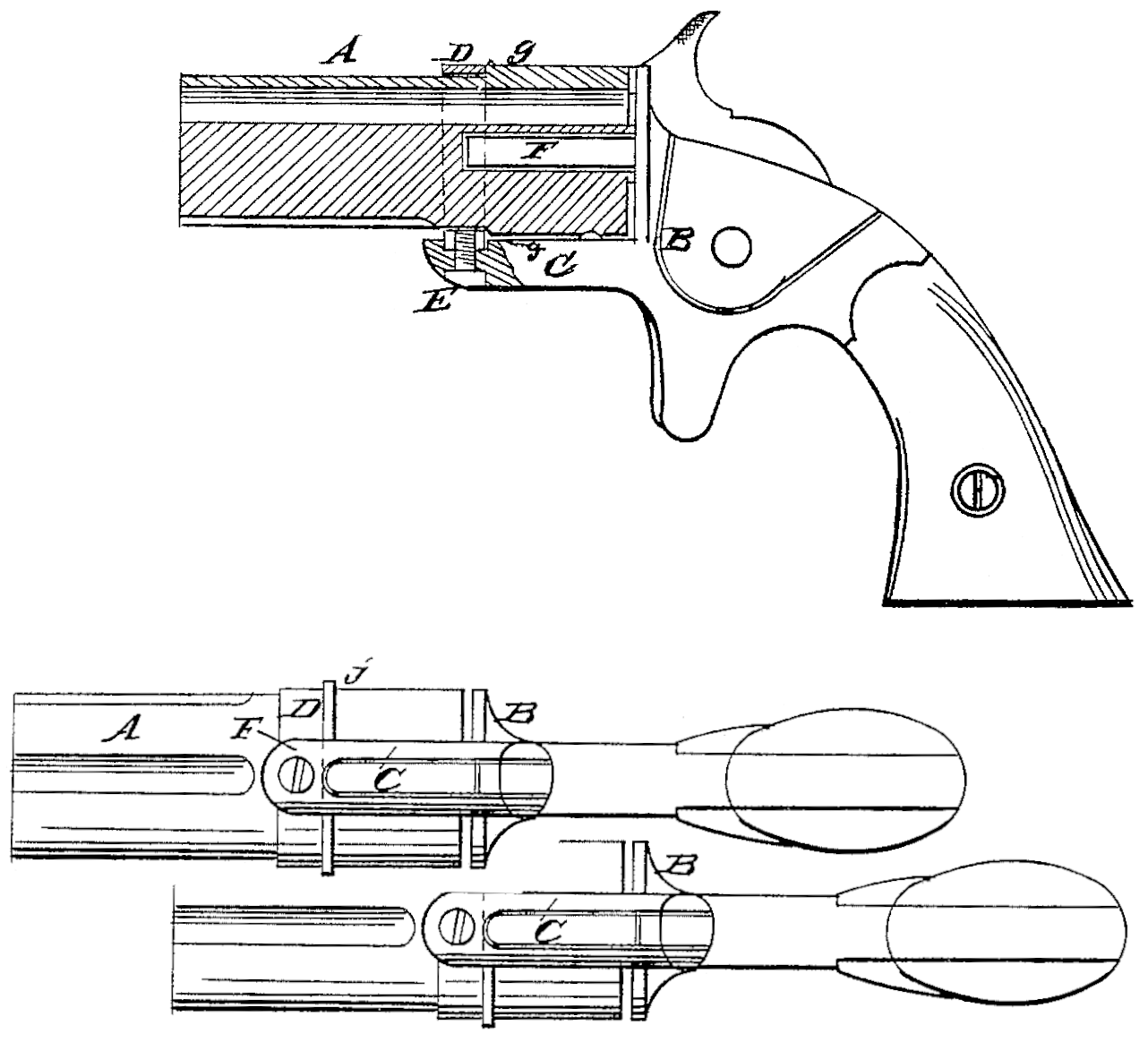US 57622
UNITED STATES PATENT OFFICE.
CHARLES A. CONVERSE AND SAMUEL S. HOPKINS, OF NORWICH, CONNECTICUT, ASSIGNORS TO THE BACON MANUFACTURING COMPANY, OF SAME PLACE.
IMPROVEMENT IN REVOLVING FIRE-ARMS.
Specification forming part of Letters Patent No. 57,622, dated August 28, 1866.
To all whom it may concern:
Be it known that we, Charles A. Converse and Samuel S. Hopkins, of Norwich, in the county of New London and State of Connecticut, have invented a new and useful Improvement in Fire-Arms; and we do hereby declare that the following is a full, clear, and exact description thereof, which will enable others skilled in the art to make and use the same, reference being had to the accompanying drawings, forming a part of this specification, in which—
Figure 1 is a longitudinal section of a revolver constructed according to our invention. Fig. 2 is an under-side view of the revolver.
Similar letters of reference indicate like parts.
In revolving many-chambered (pepper-box) repeating fire-arms several different methods have been proposed for securing the cylinder containing the barrels to the base-pin on which it revolves. One mode of applying the cylinder and of securing it in place for revolving has been to provide a movable pin running through the center and fastening to the head of the breech by means of a left-hand screw, the whole supported by a strap or continuation of the breech-frame, extending under the cylinder its whole length and turning up at its front to receive the pin, one end of which it supports. This method has been found to be inconvenient, since the pin must be unscrewed and the cylinder taken off to remove discharged shells and to reload; and, in addition to this objection, the parts are liable to be lost or to become disarranged and injured.
Our object is to improve the construction and arrangement of this kind of repeating arm; and our invention consists, among other things, in providing a better support for a so applied pepper-box cylinder, and in providing a more durable attachment thereof to the breech-piece, in accomplishing which we use a base-pin, on which the cylinder containing the barrels revolves, secured permanently and strongly to the recoil-head of the breech-frame, such base-pin projecting from the front of the recoil-head, and the center of the cylinder at its rear end being drilled about one-half of its length to receive it.
It consists, further, in so applying a flat ring or ferrule about the cylinder, and permanently securing it to a projection that extends beneath the cylinder from the breech-frame, that the cylinder may be free to revolve in the ring, but not free to move endwise, the ring holding the cylinder that contains the barrels in proper position for firing, and, in connection with a shoulder formed about the cylinder, receiving the recoil of the arm on its discharge.
The letter A designates the cylinder of a repeating fire-arm, and B its breech-frame. The rear end of the cylinder is drilled on the line of its axis, to enable it to receive the short permanent base-pin IF, which projects horizontally from the recoil-head of the breech frame. From said breech-frame projects, also, a bracket, C, which extends beneath the cylinder and close to it, but not in contact, for a distance about equal to or a little greater than the length of the base-pin.
A ring or ferrule, D, is placed around the cylinder directly in front of the circumferential shoulder g, and it is firmly secured to the end of the bracket C by means of a screw or other suitable fastening, so that the ring is made incapable of motion in any direction. The internal diameter of the ring is such that the cylinder can revolve freely in it, such revolution being effected by devices operated by the cocking of the hammer, or in any other way.
One of the results of this method of construction is that the recoil of the arm is sustained by the ring, and through it by the bracket C and breech-frame B, thereby relieving the base-pin from liability of being bent and distorted, and enabling us to use, as the axis about which the barrels revolve, a base pin which is not fastened to the cylinder, and which only penetrates it a portion of its length, thereby simplifying the construction and lessening the expense of making the cylinder, as well as leaving it stronger.
The ring D may, if desired, be supported also at its upper side by means of a duplicate bracket or strap extending from the recoil-head and fixed to the ring like the lower bracket, C. This modification is embraced within the principle of our invention, and may be used or not, as preferred by the maker.
What we claim as new, and desire to secure by Letters Patent, is—
1. The ring D, encircling the pepper-box A. in front of its shoulder g, in combination there with, and with screw E and bracket G, arranged and operating in the manner and for the purpose herein represented and described.
2. In combination, the base-pin F, about which the cylinder revolves, the ring D, the many-chambered cylinder A, and the bracket C, substantially as above shown.
CEARLES A. CONVERSE.
SAMUEL S. HOPKINS.
Witnesses:
Henry H. Hopkins,
Horace A. Briggs.

